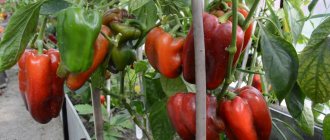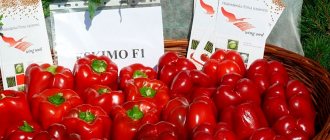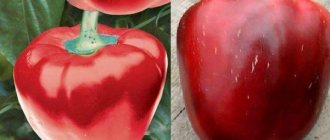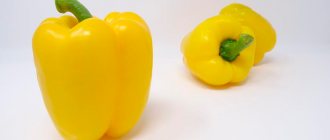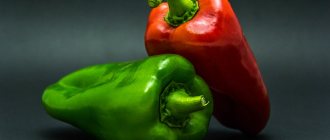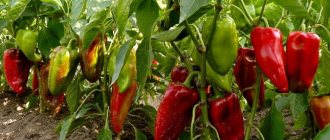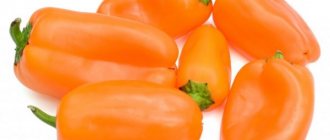| Ripening period: | early, 105-115 days |
| Shape, weight of fruits: | cylindrical, 260-280 g |
| Bush type: | determinant |
| Growing regions: | everywhere |
| Productivity: | 7.0-7.5 kg per sq. m. |
Agro has created an interesting varietal family, which includes Big Boy, Girl, Mom and Dad peppers. The vegetables are large, beautiful and high-yielding. Each species has its own advantages that attract gardeners and gardeners. The group is distinguished by a special color palette, in which Boy is characterized by the most traditional appearance. The variety was registered among Russian breeding achievements in 2012, and since then has only strengthened its position.
Description and characteristics of the variety
Early maturing Big Boy has typical characteristics of the culture:
- The semi-standard bush type provides an average plant height, which in open beds is 0.6-0.7 m; in shelter it can be slightly higher.
- The semi-spreading crown consists of small leaves of a dark green hue with a slightly wrinkled surface.
- Strong stems support the weight of the fruit and do not require additional support.
- Single or paired ovaries are actively formed, the peppers are arranged drooping.
The fruits of the Boy Big variety have the following features:
- glossy shiny surface;
- cylindrical shape;
- fruit length 150-160 mm;
- diameter of peppers 90-120 mm;
- dark red color of the peel upon reaching ripeness (see photo);
- wall thickness 7.5-8.0 mm;
- there are 3-4 seed nests inside;
- each weighs between 260-280 g.
The pepper has a pleasant taste, with a sweetish tint, without bitterness. The juicy pulp retains its presentation during transportation or storage.
The vegetable contains a large amount of ascorbic acid and minerals. The harvest is used for preparing fresh dishes, canning, and creating sauces or ketchups. The fruits also retain their taste and beneficial properties when frozen.
The register records the yield of Big Boy pepper up to 7.5 kg per square meter of planting under film soil cover.
The fruiting of the variety is extended over time, since vegetables are harvested from July to September. Ripening of fruits at the stage of technical ripeness is possible not only on the bushes, but also indoors.
Planting dates and care features
The species is designed for planting in personal gardens, while the type of soil protection depends on the climatic conditions of the region. In the south, good yields were observed in open beds. In the middle zone, Siberia or the Urals, the Big Boy sweet pepper should be grown under a greenhouse or in greenhouses.
The growing season of the variety is 105-115 days, after the appearance of green shoots.
Sowing of seeds is carried out 60-70 days before the planned transfer to the garden. For the middle zone, the sowing period is in March, and planting in the ground is in May or early June.
For every square meter of greenhouse, it is advisable to place 3-4 bushes. It is recommended to plant Big Boy pepper seedlings according to a pattern of 0.5 m between rows and 35 cm in a row.
Necessary crop care includes:
- Fertilizing every 14 days, using green fertilizers, as well as the use of phosphorus-potassium compounds twice a season after the appearance of the ovaries.
- Regular ventilation, without drafts.
- Weekly watering with warm, settled water, combined with weeding and loosening of the top layer of soil.
- Mulching with a layer of straw or crushed peat substrate.
Features of crop cultivation techniques
High yields can only be achieved from a plant that is planted and grown taking into account the recommendations. Before you start planting peppers, you should choose a good site, healthy and high-quality planting material and grow strong seedlings.
Seed selection and preparation
Seeds need to be prepared in a special way for planting.
Preparation will consist of the following stages:
- Treatment in a solution of potassium permanganate for 20–30 minutes.
- Rinse under running water.
- Soaking in a nutrient solution to improve germination, prepared according to one of the recipes: nitrophoska (1 tsp) + 1 liter of water (procedure duration - 24 hours); wood ash (1 tsp) + 1 liter of water (duration - 24 hours); liquid solution of sodium humate (duration - 24 hours, liquid temperature - +25...+28°); drug “Ideal” (duration - 24 hours, liquid temperature - +25...+28°); "Azotofit" product, 5-10 ml / 0.5 l of water (duration - 2 hours).
- Germination.
Germination is carried out as follows:
- Place a cloth at the bottom of a flat container.
- Moisten it and pour it with an aqueous solution of wood ash (1 tbsp. / 1 l).
- Sprinkle the seeds onto a damp cloth.
- Cover the container with film or glass.
- Place in temperature conditions +25…+30°С.
- Periodically moisten the seeds with a spray bottle.
Germination should occur after 1–2 weeks.
Strong seedlings can be grown if you harden the seeds. To do this, they are first placed on the bottom shelf of the refrigerator for 48 hours, and then transferred to a temperature of +18°C for 24 hours. Then the seed is put back into the refrigerator. After 2 days they are sown in the ground.
Preparing the soil for seedlings
The key to growing strong seedlings is the preparation of high-quality soil. It should be light and loose so that nutrients can quickly and easily reach the roots.
The substrate can be purchased ready-made in a specialized store or made with your own hands by mixing the following components:
- Humus (2 parts) + turf soil (1 part).
- Peat with humus (in a ratio of 1 to 1).
- Nutrient peat mixture (2 parts) + turf soil (1 part).
- Peat (4 parts) + turf soil (2 parts) + humus (1 part) + rotted sawdust (1 part).
The substrate, prepared with your own hands, requires disinfection.
Soil etching is carried out using several methods:
- Water with a dark pink solution of potassium permanganate.
- Pour boiling water over it.
- Keep in the oven at a temperature of 80–90° for 20–40 minutes.
- Place in a steam bath for 40 minutes.
- Place in the microwave on maximum mode for 10 minutes.
The treated soil is left to sit for a couple of weeks so that it becomes populated with beneficial bacteria. Immediately before planting, it is well moistened.
Timing of sowing seeds
Seeds are planted in the ground in late February - early March. In this case, planting sprouts in the ground can be done at the end of April in a heated greenhouse and in May in an unheated shelter, at the beginning of June - in open ground.
For growing seedlings, use a long box or separate containers measuring 10 x 10 (plastic cups, peat pots, tablets, cassettes). The latter option is preferable, since in this case there is no need to pick, which can lead to damage to the delicate roots.
In one large container, the seeds are sown in furrows to a depth of 1–1.5 cm. A distance of 3–4 cm is left between the furrows. In separate containers, make 2 holes 1–1.5 cm deep and place 1 seed in them. The seeds are sprinkled with soil. The containers are covered with film or glass. Then they are placed in a warm room.
Features of caring for seedlings
When seedlings appear, the cover must be removed. In the first week after this, the seedlings are grown at a temperature of +13...+16°C during the day and +8...+10°C at night. Then they are returned to warm conditions with a temperature range of +20...+27°C.
Seedlings should be moistened once a week. Watering should be plentiful. It is important to ensure that drops do not fall on the stems and leaves. When grown in one box, picking is done when 2–4 leaves appear. Seedlings are planted in separate containers with a volume of 0.5 liters.
Fertilizers are applied 14 days after picking. Use a mixture of superphosphate (50 g) with urea (5 g) and water (10 l). The second application is carried out 3-4 days before moving the sprouts to a permanent place. At this time, add a mixture of superphosphate (50 g) with potassium sulfate (25 g), diluted in a bucket of water. Ready-made fertilizers are also quite suitable, for example, “Agricola”, “Mortar”, “Krepysh”.
Diseases and pests
Big boba is resistant to the tobacco mosaic virus, which can cause significant harm to the plant.
Information from the seed manufacturer and reviews from gardeners do not indicate immunity from other diseases. Thus, pepper should be additionally treated against:
- late blight susceptible to preparations based on copper compounds;
- cladosporiosis, which is destroyed by fungicides;
- blossom end rot, which appears due to a lack of calcium.
In addition, plants may suffer from verticillium, blackleg or phytoplasmosis, which cannot be cured. For prevention, it is important to disinfect garden tools, greenhouses, soil and planting material.
Among the pests that pose a danger to the Boy variety are:
- Colorado beetle;
- spider mite;
- aphid.
When insects appear, the bushes are treated with insecticides of biological or chemical origin.
Other varieties of the “Big” series
The large-fruited Big Boy pepper is part of a varietal group that also includes:
- Big Daddy;
- Big Mom;
- Big girl.
The most original of all is the Big Daddy pepper, because the fruits have an original purple color. This shade corresponds to technical ripeness; upon reaching biological maturation, it becomes brownish-red. The shape of the vegetables is conical, and the weight is small - about 100 g, which affects the volume of the harvest. From each meter of plantings you can collect 5.0-5.5 kg both in closed ground and in open beds. The variety begins to bear fruit after 110-120 days of growing season. Bushes of medium height, semi-spreading. The advantage of plants is their high resistance to major crop diseases.
The Big Mama pepper variety is distinguished by its high yield of 7 to 8 kg per square meter. The dimensions of the bushes depend on the type of soil cover. Without protection, plants do not exceed half a meter in height, and under a greenhouse they grow up to 1 m, while forming a more spreading crown. In greenhouses, it is recommended to tie the bushes to a trellis and form them into 2 stems, removing the flower at the first branch. The fruits are beautiful, orange in color, large, similar to a cylinder. The average weight of pepper is 120 g, and the wall thickness reaches 7 mm. Unlike the rest of the group, the species is resistant to cold weather and low light, so seeds can be sown 1-2 weeks earlier.
The last representative of the group is Big Girl pepper. The variety is also early ripening with a growing season of 105 to 110 days. Equally, seedlings take root in open or closed ground. Low semi-standard bushes do not require staking or shaping. The fruit set is very active; at the same time there are 8-10 peppers on the plant. The vegetables are large, thick-walled, trapezoidal, weighing up to 200 g. The average productivity of the variety is 6-7 kg per square meter. Among the advantages is resistance to crop diseases and temperature changes.
Features of agricultural technology
To obtain strong and healthy seedlings, their age should be approximately 65-70 days. Therefore, depending on the area of residence, summer residents themselves navigate the timing of the start of sowing work.
Growing seedlings
Before sowing peppers, prepare the soil for seedlings. To do this, you can use various types of soils that are offered by trade, or prepare the soil mixture yourself.
To do this, garden or garden soil is mixed with compost and ash. If the mixture is not loose and light enough, add peat or coconut substrate. To destroy pathogenic bacteria, the soil is disinfected with a weak solution of potassium permanganate.
May be interesting Lunar calendar for planting hot peppers for seedlings in 2022 The best varieties of peppers for open ground Advantages and disadvantages of the cucumber variety “Hit of the season f1”
Boxes for seedlings should have drainage holes in the bottom to avoid stagnation of water when watering.
Before sowing, the seeds are treated:
- For disinfection - in a solution of phytosporin or potassium permanganate (15-20 minutes), then washed.
- In a solution of growth stimulants or microelements (5-6 hours).
- The treated seeds are wrapped in a damp cloth, placed in a bag or jar, which is placed in a room with a temperature of 24-25 degrees.
- Keep moist, adding a little water if necessary to avoid drying out.
To improve germination, you can use seed treatment using bubbling - for which, before soaking, the seeds are placed in a jar of water and a compressor (can be an aquarium compressor) creates a flow of air bubbles.
The seeds hatch after 4-5 days, after which they are sown in prepared, moist soil. When planting in boxes, the distance between seeds is 3-4 cm, and 7-8 mm of soil is poured on top.
To speed up the germination of peppers, the boxes are covered with film or paper to create a greenhouse effect, and placed at a temperature of 24-25 degrees. until the seedlings appear.

